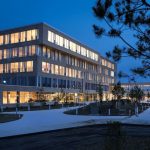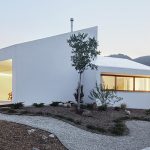Christian Karlsson will talk about the largest and most ambitious psychiatry construction in Denmark in more than 100 years at GIS 2017
Architect Christian Karlsson, founder of Karlsson Architects, Denmark, will be GUEST SPEAKER at GIS- International interior architecture and design expo conference, and will present the project „Psychiatric hospital in Slagelse, Denmark”. The International Forum of Architecture and Engineering SHARE Bucharest is the largest event dedicated to architects, engineers, contractors and will take place on March 21-22 at JW Marriott Bucharest Grand Hotel.
‘The new psychiatric hospital in Slagelse is the lighthouse of the future psychiatry on an international plane’. – has said the client
Karlsson Architects / VLA won the 2-phase competition for the proposal of the new psychiatric hospital in Slagelse which embodies the largest and most ambitious construction for psychiatry in Denmark in more than 100 years and was completed in September 2015. With the total area of 44,000 m2, the building consists of general psychiatric, forensic and high security wards, outpatient clinic, emergency reception, training facilities, swimming pool and a center for research and education. The overall capacity includes 194 hospitalized patients and 200-300 daily consultations in the outpatient clinic.
Transparency between people and functions has been the key in developing the overall layout and design. That includes consistent use of glass walls between relevant functions – e. g. workspaces, meeting rooms and activity facilities, giving the building a personal and lively atmosphere. Using glass in designing the working areas for the staff in each ward gives the possibility of overviewing the ward and the common areas shared between 2 – 3 wards. This underlines the notion of proximity and allows easy access to staff, but also supports the strategy of dynamic security.
Focusing on recovery and healing architecture, one of the projects’ bearing ideas includes optimising the daylight and working with ground-breaking LED-lighting. The project is complemented by a circadian rhythm lighting design, which is based on a dynamic LED technology, supporting the work with patients through both day and night. The lights vary in colour, intensity and composition, depending on the time of the day. A series of studies have proven that this supports the treatment of the patients and limits the stress levels of the staff working during night shifts.
The building is organized and designed in an informal and open way, around eventful unity of spaces and inner courtyards-gardens. The separate sections of the hospital are joined through common facilities for treatments, activities, training, cooking and outdoor spaces, supporting the innovative organization of the future psychiatrics.
From the outside, the building looks uncomplicated with warm yellow handmade bricks used on the facade. The surrounding gently mountainous landscape with wild grass and groups of oak trees form a welcoming and supporting atmosphere for everyone arriving or leaving the building.
The synergy and knowledge sharing between the staff is accommodated through open activity based work spaces designed for the specialists working across treatment, research and education. The project is a result of a fruitful collaboration between the architects, psychiatry specialists and patient groups through the many user involvement workshops held during the designing process. Thanks to that the state of the art Danish psychiatry principles have been successfully translated into architecture that is supportive, warm and welcoming with each single patient in the focus.
For majority of the psychiatric patients, a substantial part of the treatment consists of maintaining social competences and basic skills. Sports and other physical activities are included in the therapy to increase their engagement and activity levels, helping them to adjust better. Patients can access facilities, such as two sports halls, swimming pool and outdoor training areas. Furthermore, more than 40 courtyards and gardens that differ in size and character give a variety of options for outdoor activities for both patients and staff. The inventory and planting supports the notion of changing seasons and supplements with stimulating observations of weather, birds etc.
About the architect
From 1993 until 2003, Christian Karlsson was Architect and Associated Partner in KHR Architects, in charge of projects for new Metro stations København/Frederiksberg, Flintholm metro station and University of Odense.
In 2003 he was the Head of The Danish for Building and Property Agency (SES) with the responsibility for the development and maintenance of the state’s properties and castles until 2007 when he established Karlsson Arkitekter. He was in charge of the project New psychiatric Hospital I Slagelse (lead consultant), New Psychiatric Hospital in Vejle DK (OPP consultant), Domicile for The ministry of Housing, Urban and Rural Affairs (lead consultant).
Currently, Christian Karlsson is an associated Professor at the Royal Academy of Fine Arts, Copenhagen and member of the Danish Society of Artists. He was appointed judge at national architectural competitions in Danemark.
Christian Karlsson has several international and national architectual awards: Architectual Review Award 2016 (Health Buildings), WAF Award 2016 / Finalist, WAN Award / Finalist, The Construction Client Award 2016, The Danish Architecture Award Farveprisen 2016, Goldlabel Danish Green Building Counsil 2016, The Danish Light Prize 2016 / Finalist and The Danish Architecture Award Tyndpladeprisen 2009.
The tickets can be booked here.
























